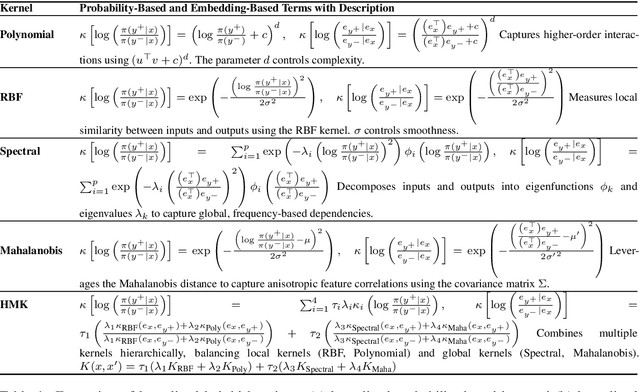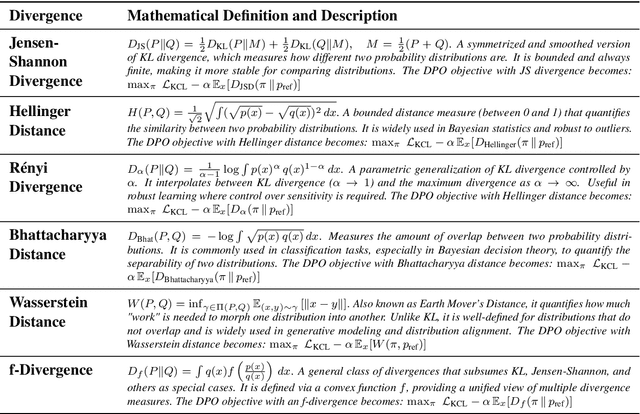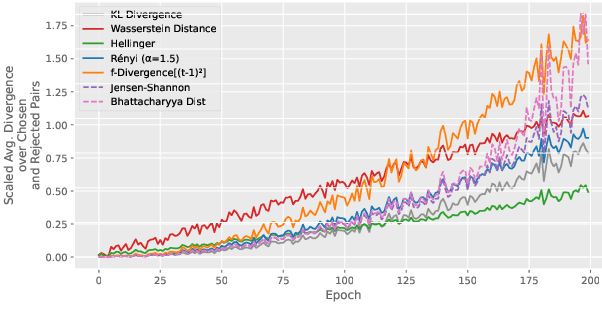Vinija Jain
YINYANG-ALIGN: Benchmarking Contradictory Objectives and Proposing Multi-Objective Optimization based DPO for Text-to-Image Alignment
Feb 05, 2025Abstract:Precise alignment in Text-to-Image (T2I) systems is crucial to ensure that generated visuals not only accurately encapsulate user intents but also conform to stringent ethical and aesthetic benchmarks. Incidents like the Google Gemini fiasco, where misaligned outputs triggered significant public backlash, underscore the critical need for robust alignment mechanisms. In contrast, Large Language Models (LLMs) have achieved notable success in alignment. Building on these advancements, researchers are eager to apply similar alignment techniques, such as Direct Preference Optimization (DPO), to T2I systems to enhance image generation fidelity and reliability. We present YinYangAlign, an advanced benchmarking framework that systematically quantifies the alignment fidelity of T2I systems, addressing six fundamental and inherently contradictory design objectives. Each pair represents fundamental tensions in image generation, such as balancing adherence to user prompts with creative modifications or maintaining diversity alongside visual coherence. YinYangAlign includes detailed axiom datasets featuring human prompts, aligned (chosen) responses, misaligned (rejected) AI-generated outputs, and explanations of the underlying contradictions.
IndicMMLU-Pro: Benchmarking the Indic Large Language Models
Jan 27, 2025Abstract:Known by more than 1.5 billion people in the Indian subcontinent, Indic languages present unique challenges and opportunities for natural language processing (NLP) research due to their rich cultural heritage, linguistic diversity, and complex structures. IndicMMLU-Pro is a comprehensive benchmark designed to evaluate Large Language Models (LLMs) across Indic languages, building upon the MMLU Pro (Massive Multitask Language Understanding) framework. Covering major languages such as Hindi, Bengali, Gujarati, Marathi, Kannada, Punjabi, Tamil, Telugu, and Urdu, our benchmark addresses the unique challenges and opportunities presented by the linguistic diversity of the Indian subcontinent. This benchmark encompasses a wide range of tasks in language comprehension, reasoning, and generation, meticulously crafted to capture the intricacies of Indian languages. IndicMMLU-Pro provides a standardized evaluation framework to push the research boundaries in Indic language AI, facilitating the development of more accurate, efficient, and culturally sensitive models. This paper outlines the benchmarks' design principles, task taxonomy, data collection methodology, and presents baseline results from state-of-the-art multilingual models.
DPO Kernels: A Semantically-Aware, Kernel-Enhanced, and Divergence-Rich Paradigm for Direct Preference Optimization
Jan 08, 2025



Abstract:The rapid rise of large language models (LLMs) has unlocked many applications but also underscores the challenge of aligning them with diverse values and preferences. Direct Preference Optimization (DPO) is central to alignment but constrained by fixed divergences and limited feature transformations. We propose DPO-Kernels, which integrates kernel methods to address these issues through four key contributions: (i) Kernelized Representations with polynomial, RBF, Mahalanobis, and spectral kernels for richer transformations, plus a hybrid loss combining embedding-based and probability-based objectives; (ii) Divergence Alternatives (Jensen-Shannon, Hellinger, Renyi, Bhattacharyya, Wasserstein, and f-divergences) for greater stability; (iii) Data-Driven Selection metrics that automatically choose the best kernel-divergence pair; and (iv) a Hierarchical Mixture of Kernels for both local precision and global modeling. Evaluations on 12 datasets demonstrate state-of-the-art performance in factuality, safety, reasoning, and instruction following. Grounded in Heavy-Tailed Self-Regularization, DPO-Kernels maintains robust generalization for LLMs, offering a comprehensive resource for further alignment research.
LLMsAgainstHate @ NLU of Devanagari Script Languages 2025: Hate Speech Detection and Target Identification in Devanagari Languages via Parameter Efficient Fine-Tuning of LLMs
Dec 26, 2024Abstract:The detection of hate speech has become increasingly important in combating online hostility and its real-world consequences. Despite recent advancements, there is limited research addressing hate speech detection in Devanagari-scripted languages, where resources and tools are scarce. While large language models (LLMs) have shown promise in language-related tasks, traditional fine-tuning approaches are often infeasible given the size of the models. In this paper, we propose a Parameter Efficient Fine tuning (PEFT) based solution for hate speech detection and target identification. We evaluate multiple LLMs on the Devanagari dataset provided by (Thapa et al., 2025), which contains annotated instances in 2 languages - Hindi and Nepali. The results demonstrate the efficacy of our approach in handling Devanagari-scripted content.
On the Feasibility of Vision-Language Models for Time-Series Classification
Dec 23, 2024Abstract:We build upon time-series classification by leveraging the capabilities of Vision Language Models (VLMs). We find that VLMs produce competitive results after two or less epochs of fine-tuning. We develop a novel approach that incorporates graphical data representations as images in conjunction with numerical data. This approach is rooted in the hypothesis that graphical representations can provide additional contextual information that numerical data alone may not capture. Additionally, providing a graphical representation can circumvent issues such as limited context length faced by LLMs. To further advance this work, we implemented a scalable end-to-end pipeline for training on different scenarios, allowing us to isolate the most effective strategies for transferring learning capabilities from LLMs to Time Series Classification (TSC) tasks. Our approach works with univariate and multivariate time-series data. In addition, we conduct extensive and practical experiments to show how this approach works for time-series classification and generative labels.
Hate Speech Detection and Target Identification in Devanagari Languages via Parameter Efficient Fine-Tuning of LLMs
Dec 22, 2024Abstract:The detection of hate speech has become increasingly important in combating online hostility and its real-world consequences. Despite recent advancements, there is limited research addressing hate speech detection in Devanagari-scripted languages, where resources and tools are scarce. While large language models (LLMs) have shown promise in language-related tasks, traditional fine-tuning approaches are often infeasible given the size of the models. In this paper, we propose a Parameter Efficient Fine tuning (PEFT) based solution for hate speech detection and target identification. We evaluate multiple LLMs on the Devanagari dataset provided by (Thapa et al., 2025), which contains annotated instances in 2 languages - Hindi and Nepali. The results demonstrate the efficacy of our approach in handling Devanagari-scripted content.
SKETCH: Structured Knowledge Enhanced Text Comprehension for Holistic Retrieval
Dec 19, 2024



Abstract:Retrieval-Augmented Generation (RAG) systems have become pivotal in leveraging vast corpora to generate informed and contextually relevant responses, notably reducing hallucinations in Large Language Models. Despite significant advancements, these systems struggle to efficiently process and retrieve information from large datasets while maintaining a comprehensive understanding of the context. This paper introduces SKETCH, a novel methodology that enhances the RAG retrieval process by integrating semantic text retrieval with knowledge graphs, thereby merging structured and unstructured data for a more holistic comprehension. SKETCH, demonstrates substantial improvements in retrieval performance and maintains superior context integrity compared to traditional methods. Evaluated across four diverse datasets: QuALITY, QASPER, NarrativeQA, and Italian Cuisine-SKETCH consistently outperforms baseline approaches on key RAGAS metrics such as answer_relevancy, faithfulness, context_precision and context_recall. Notably, on the Italian Cuisine dataset, SKETCH achieved an answer relevancy of 0.94 and a context precision of 0.99, representing the highest performance across all evaluated metrics. These results highlight SKETCH's capability in delivering more accurate and contextually relevant responses, setting new benchmarks for future retrieval systems.
* 16 pages, 8 figures, Workshop on Generative AI and Knowledge Graphs (GenAIK) at The 31st International Conference on Computational Linguistics (COLING 2025)
Exploring the Abilities of Large Language Models to Solve Proportional Analogies via Knowledge-Enhanced Prompting
Dec 01, 2024



Abstract:Making analogies is fundamental to cognition. Proportional analogies, which consist of four terms, are often used to assess linguistic and cognitive abilities. For instance, completing analogies like "Oxygen is to Gas as <blank> is to <blank>" requires identifying the semantic relationship (e.g., "type of") between the first pair of terms ("Oxygen" and "Gas") and finding a second pair that shares the same relationship (e.g., "Aluminum" and "Metal"). In this work, we introduce a 15K Multiple-Choice Question Answering (MCQA) dataset for proportional analogy completion and evaluate the performance of contemporary Large Language Models (LLMs) in various knowledge-enhanced prompt settings. Specifically, we augment prompts with three types of knowledge: exemplar, structured, and targeted. Our results show that despite extensive training data, solving proportional analogies remains challenging for current LLMs, with the best model achieving an accuracy of 55%. Notably, we find that providing targeted knowledge can better assist models in completing proportional analogies compared to providing exemplars or collections of structured knowledge.
Visual Counter Turing Test (VCT^2): Discovering the Challenges for AI-Generated Image Detection and Introducing Visual AI Index (V_AI)
Nov 24, 2024Abstract:The proliferation of AI techniques for image generation, coupled with their increasing accessibility, has raised significant concerns about the potential misuse of these images to spread misinformation. Recent AI-generated image detection (AGID) methods include CNNDetection, NPR, DM Image Detection, Fake Image Detection, DIRE, LASTED, GAN Image Detection, AIDE, SSP, DRCT, RINE, OCC-CLIP, De-Fake, and Deep Fake Detection. However, we argue that the current state-of-the-art AGID techniques are inadequate for effectively detecting contemporary AI-generated images and advocate for a comprehensive reevaluation of these methods. We introduce the Visual Counter Turing Test (VCT^2), a benchmark comprising ~130K images generated by contemporary text-to-image models (Stable Diffusion 2.1, Stable Diffusion XL, Stable Diffusion 3, DALL-E 3, and Midjourney 6). VCT^2 includes two sets of prompts sourced from tweets by the New York Times Twitter account and captions from the MS COCO dataset. We also evaluate the performance of the aforementioned AGID techniques on the VCT$^2$ benchmark, highlighting their ineffectiveness in detecting AI-generated images. As image-generative AI models continue to evolve, the need for a quantifiable framework to evaluate these models becomes increasingly critical. To meet this need, we propose the Visual AI Index (V_AI), which assesses generated images from various visual perspectives, including texture complexity and object coherence, setting a new standard for evaluating image-generative AI models. To foster research in this domain, we make our https://huggingface.co/datasets/anonymous1233/COCO_AI and https://huggingface.co/datasets/anonymous1233/twitter_AI datasets publicly available.
ViBe: A Text-to-Video Benchmark for Evaluating Hallucination in Large Multimodal Models
Nov 16, 2024



Abstract:Latest developments in Large Multimodal Models (LMMs) have broadened their capabilities to include video understanding. Specifically, Text-to-video (T2V) models have made significant progress in quality, comprehension, and duration, excelling at creating videos from simple textual prompts. Yet, they still frequently produce hallucinated content that clearly signals the video is AI-generated. We introduce ViBe: a large-scale Text-to-Video Benchmark of hallucinated videos from T2V models. We identify five major types of hallucination: Vanishing Subject, Numeric Variability, Temporal Dysmorphia, Omission Error, and Physical Incongruity. Using 10 open-source T2V models, we developed the first large-scale dataset of hallucinated videos, comprising 3,782 videos annotated by humans into these five categories. ViBe offers a unique resource for evaluating the reliability of T2V models and provides a foundation for improving hallucination detection and mitigation in video generation. We establish classification as a baseline and present various ensemble classifier configurations, with the TimeSFormer + CNN combination yielding the best performance, achieving 0.345 accuracy and 0.342 F1 score. This benchmark aims to drive the development of robust T2V models that produce videos more accurately aligned with input prompts.
 Add to Chrome
Add to Chrome Add to Firefox
Add to Firefox Add to Edge
Add to Edge